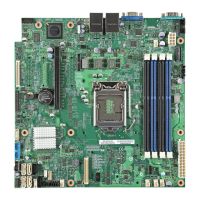Intel® Server Board S1200V3RP TPS Intel® Light Guided Diagnostics
Revision 1.2
11.1 System ID LED
The server board includes a blue system ID LED which is used to visually identify a specific
server installed among many other similar servers. There are two options available for
illuminating the System ID LED.
1. The front panel ID LED Button is pushed, which causes the LED to illuminate to a solid
on state until the button is pushed again.
2. An IPMI Chassis Identify command is remotely entered, which causes the LED to blink.
The System ID LED on the server board is tied directly to the System ID LED on system front
panel if present.
11.2 System Status LED
The server board includes a bi-color System Status LED. The System Status LED on the server
board is tied directly to the System Status LED on the front panel (if present). This LED
indicates the current health of the server. Possible LED states include solid green, blinking
green, blinking amber, and solid amber.
When the server is powered down (transitions to the DC-off state or S5), the BMC is still on
standby power and retains the sensor and front panel status LED state established before the
power-down event.
When AC power is first applied to the system, the status LED turns solid amber and then
immediately changes to blinking green to indicate that the BMC is booting. If the BMC boot
process completes with no errors, the status LED will change to solid green.
Table 59. System Status LED State Definitions
1. System is powered off (AC and/or DC).
2. System is in EuP Lot6 Off Mode.
3. System is in S5 Soft-Off State.
4. System is in S4 Hibernate Sleep State.
Indicates that the System is running (in S0 State) and its status is
‘Healthy’. The system is not exhibiting any errors. AC power is
present and BMC has booted and manageability functionality is up
and running.
Degraded -
system is
operating in a
degraded state
although still
functional, or
system is
operating in
a redundant state
but with an
impending failure
warning
System degraded:
Redundancy loss, such as power-supply or fan. Applies only if the
associated platform sub-system has redundancy capabilities.
Fan warning or failure when the number of fully operational fans is
more than minimum number needed to cool the system.
Non-critical threshold crossed – Temperature (including HSBP temp),
voltage, input power to power supply, output current for main power
rail from power supply and Processor Thermal Control (Therm Ctrl)
sensors.
Power supply predictive failure occurred while redundant power
supply configuration was present.
Unable to use all of the installed memory (one or more DIMMs

